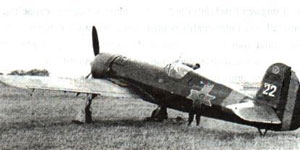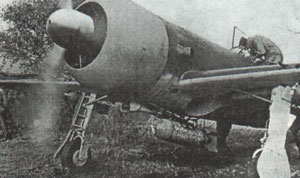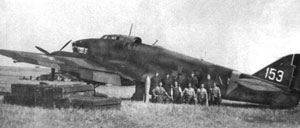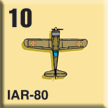| Armata Romana:
Romanian Air Power
By Mike Bennighof, Ph.D.
July 2024
 Romania founded an air force, the Fortele Aeriene Regale
ale Romaniei (or FARR) in 1913. During the Great War the FARR
made little contribution, as its obsolete foreign-made aircraft
could not be repaired or replaced. Afterwards, the Romanian
government decided to build up its own aircraft industry,
so as not to be at the mercy of foreign suppliers. Romania founded an air force, the Fortele Aeriene Regale
ale Romaniei (or FARR) in 1913. During the Great War the FARR
made little contribution, as its obsolete foreign-made aircraft
could not be repaired or replaced. Afterwards, the Romanian
government decided to build up its own aircraft industry,
so as not to be at the mercy of foreign suppliers.
While the policy appeared sound on paper, in practice it
proved much more difficult to execute. Large amounts of money
disappeared or were wasted on useless projects. When Romania
finally entered the Second World War in June 1941, most of
the FARR’s aircraft were foreign made — French,
Italian, Polish, German or British.
For the initial campaign, the FARR concentrated its striking
power in the Combat Air Group (Gruparea Aeriana de Lupta,
or GAL). The GAL had 205 combat-ready aircraft, including
the FARR’s best planes — German-made Bf109E fighters,
Italian-made SM.79 bombers (or the Romanian license-built
version, the JRS79), Polish PZL 37 medium bombers and PZL
23 light bombers, and French Potez 633 bombers. Plus three
squadrons operated the new Romanian-built IAR-80 fighter-bombers,
a modern all-metal monoplane designed by Ion Grosu and Ion
Cosereanu.

A Stuka in Romanian livery.
During the campaign in Bessarabia and the siege of Odessa, Romanian pilots
with the bravado typical of their caste in every country claimed
597 enemy aircraft destroyed — slightly more than the
total deployed in the theater by the Red Air Force. Against
this score, the FARR lost 40 airplanes. But even allowing
for exaggeration, the FARR did well in air-to-air combat.

An IAR-80 fighter on the flight line.
What greatly inhibited the FARR in the 1941 campaign was a
great lack of mobile base facilities. The squadrons could
not easily be supported near the front, and had to fly longer
and longer distances as the Romanian army penetrated into
Soviet-held territory. All branches of the Romanian military
lacked motor vehicles, and the FARR had not equipped itself
to move into the Soviet Union. In any future war, its leaders
expected to wage the entire conflict from their pre-war bases.
Trucks had to be borrowed from the army, which did not have
nearly enough for its own needs. Romanian squadrons operating
in the Soviet Union did so almost exclusively from former
Soviet bases or German ones.
Romania also did not have a dedicated ground-support plane
in the war’s early months. Squadrons with IAR-80 fighters
flew support missions, as did bomber squadrons of all types.
Not until 1943 did the Germans supply modern attack craft,
when Ju-87D dive bombers and Hs.129 attack planes were loaned
to the FARR. To make up for the lack, a variant of the IAR-80,
the IAR-81, went into production as a dive bomber.

An IAR-81 is prepped for a mission.
Romania had tried to order fifty Ju-87B dive bombers in
1939, but the Germans refused the order. In July 1940, the
home-grown IAR-37 biplane dive-bomber was finally declared
a failure, though the plane would be used for light bombing
and reconnaissance duties during the war. In May 1941, IAR
experimented with an IAR-80 fighter fitted with dive brakes
and a large bomb cradle slung low under the aircraft. Though
not a very satisfactory dive-bomber, it was better than the
IAR-37 and all the FARR had. The first planes went to the
front in late October 1941, just after the fall of Odessa.
In 1943, with the loan of much better German aircraft to
the FARR, the IAR-80 and IAR-81 aircraft returned to Romania
and fought against American bombing raids until Romania joined
the Allies in August 1944. They did well against American
P-38 Lightning fighters at low altitude and brought down a
number of B-24 bombers, but had no chance at higher altitudes
against American P-51 Mustang fightere and suffered heavy
losses.

A JRS-79 with crew.
Without a decent attack plane, the FARR also used its best
medium bombers in the ground-support role. The JRS-79 originated
from an order for Italian-made SM-79 bombers. The Romanians
liked the plane, a tri-motor monoplane with much more modern
characteristics than its appearance implies, but wanted a
version with two more powerful engines and a glassed-in nose.
This model, the JRS-79, did not appear until August 1941.
Eight of these came from Savoia-Marchetti in 1941, 36 more
from IAR in 1942 and 30 in 1944 (with six more being delivered
in 1946).
The SM-79 was a fine torpedo plane in Italian hands and an
adequate medium bomber; for close-support it proved very vulnerable
to ground fire and the FARR lost two of them on their very
first sortie. But lacking anything better, the FARR kept them
flying in this role until 1943, when German-made planes took
over the duty. They returned to action during Romania’s
war against the Nazis, and the last JRS-79 lost in action
was shot down on 21 April 1945.

In Panzer
Grenadier: Armata Romana there’s one Romanian
aircraft piece. One side has an SM-79, the flip side is an
IAR-80. Since the IAR-80 didn’t print well (the counter
is perfectly usable; it’s just not pretty enough for
our tastes) we have a replacement here in our free
download.
We’ve also provided two more aircraft pieces, though
the Romanian player is never allowed to draw more than one
in any scenario — the FARR did not provide support on
anything like the scale of the Luftwaffe or even the Red Air
Force. But this will add a little more variety, and aid in
creating fantasy scenarios for those Romanophiles out there
(well, at least the one who’s written in to us).
Click
here to order Armata Romana and send Armata Romana into battle!
Sign up for our newsletter right here. Your info will never be sold or transferred; we'll just use it to update you on new games and new offers.
Mike Bennighof is president of Avalanche Press and holds a doctorate in history from Emory University. A Fulbright Scholar and NASA Journalist in Space finalist, he has published an unknowable number of books, games and articles on historical subjects.
He lives in Birmingham, Alabama with his wife and three children; he misses his dog, Leopold.
Want to keep Daily Content free of third-party ads? You can send us some love (and cash) through this link right here.
|
